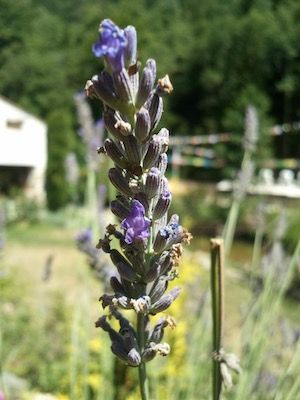LAVENDER
I- Nomenclature
Latin name: Lavandula angustifolia
Family : Lamiaceae
Common names: Garden Lavender, common lavender, narrow-leaved lavender1, Lavandula officinalis, Lavandula spica, Lavandula vera2
Etymology
Lavandula ”comes from the Latin“ lavare ”: to wash.
From the Latin “angustifolia”: with narrow leaves.
II- Legends and traditions
The early Greeks learned a lot about Lavender flower perfumes and the use of aromatic herbs from the Egyptians. The Romans learned about this knowledge from the Greeks and used Lavender flower lavishly in their public baths, to perfume themselves and their homes. They also valued it for treating ailments.
English royalty were particularly fond of Lavender during the Victorian Era.The Queen Victoria even appointed a official purveyor, her name was Miss Sarah Sprules "Purveyor to the Queen", and it was used throughout the castles for everything imaginable. Floors and furniture were washed and all the linens perfumed with its sweet scent.3
III- Botanical description
Description: Aromatic bushy shrub of 30 to 60 cm with woody stumps and herbaceous stems, erect and simple.
The leaves are narrow, linear, opposite, sessile and hairy.
The flowers are blue-mauve or lilac, bilabiate (petals forming two lips), whorled and grouped in terminal spikes.
The fruits are tetrakenes.
Habitat: Originally from Persia, lavender is a xerophilic plant that grows naturally in arid, limestone and sunny lands.
Harvest: The flowering tops are harvested at the start of flowering to be dried in bouquets suspended in dry and ventilated places.
After desiccation, the lavender stems are beaten to detach the flowers.
Pars used : Flowers
IV- Active ingredients
|
• Essential oils • Terpene alcohols: linalol and lavandulol • Esters: linalyl acetate • Tannins: astribgents and bactericides |
V- Therapeutic uses
Properties
|
• Analgesic • Anti-migraine • Antispasmodic • Broad spectrum antiseptic: antibacterial, antimicrobial, antiparasitic and antiviral • Astringent • Bechic • Calming • Healing • Muscle relaxant • Hypnotic • Cardiac regulator • Vulnerary |
Indications
Nervous disorders: anxiety, dyspepsia, hyperemotivity, nervousness, irritability and sleep disturbances.
Associations: hawthorn, hops, lime or valerian in mixtures of hypnotic plants.
Rich in linalool, lavender herbal teas fight winter diseases of the upper respiratory tract: bronchitis, laryngitis, pharyngitis as well as colds at the first signs.
Dosage
Internal use
Infusion: 40gr / liter of water, 3 or 4 cups per day
Essential oil: 3 to 9 drops per day
Alcoholature: 3 or 4 grams per day
External use
Frictions: essential oil on the thorax in pulmonary diseases (associated with eucalyptus).
Gargle: a drop of essential oil in a little water.
Essential oil: wounds, wounds, contusions: a few drops of essential oil on the suffering part.
In case of nervousness, palpitations, insomnia: essential oil associated with Marjoram or Orange tree.
Injection:15g / liter and 2 or 3 drops of gasoline against leucorrhea.
Infusion:rheumatism, gout: infusion of 30gr / liter of water.
VI- Precaution of use
Caution
The use of essential oil should be the subject of the judicious advice of an aromatherapist.
1 https://en.wikipedia.org/wiki/Lavandula_angustifolia
2 http://www.naturalmedicinalherbs.net/herbs/l/lavandula-angustifolia=lavender.php
3 https://everything-lavender.com/history-of-lavender.htm



